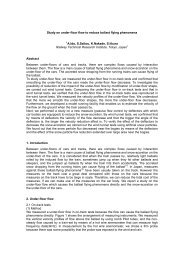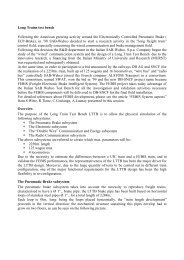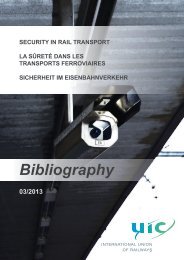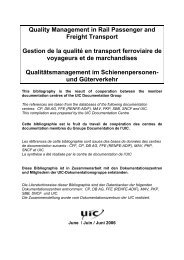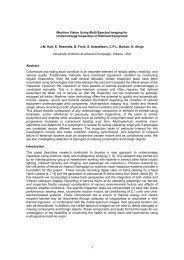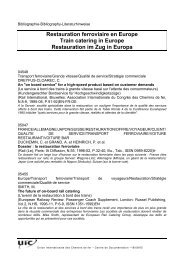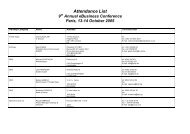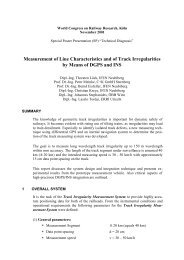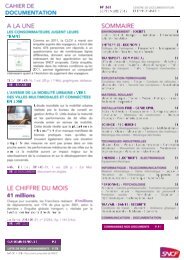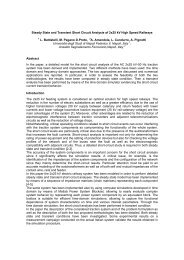Simulations of railway junction operation - UIC
Simulations of railway junction operation - UIC
Simulations of railway junction operation - UIC
You also want an ePaper? Increase the reach of your titles
YUMPU automatically turns print PDFs into web optimized ePapers that Google loves.
ID Number: 005<br />
<strong>Simulations</strong> <strong>of</strong> <strong>railway</strong> <strong>junction</strong> <strong>operation</strong><br />
Antonín Kavicka, Valent Klima<br />
Faculty <strong>of</strong> Management Science and Informatics<br />
University <strong>of</strong> Zilina, Slovak Republic<br />
kavicka@frdsa.fri.utc.sk, klima@frdsa.fri.utc.sk<br />
Introduction<br />
Nowadays there is paid an essential attention to modernisation and reorganisation <strong>of</strong> <strong>railway</strong><br />
companies in the field <strong>of</strong> freight and passenger traffic with the goal to assure the high level <strong>of</strong><br />
effectiveness. The <strong>railway</strong> <strong>junction</strong>s play very important role within the mentioned process <strong>of</strong><br />
<strong>railway</strong> modernisation. There is usually needed to invest into the new technical equipment, to<br />
rationalise the work <strong>of</strong> service resource, to modify <strong>railway</strong> processes, to react to the changed<br />
flows <strong>of</strong> incoming trains etc. Hence, in order to adopt the essential decisions connected with<br />
reengineering <strong>of</strong> <strong>railway</strong> <strong>junction</strong>s it is necessary to study the consequences in advance within<br />
the frame <strong>of</strong> suitable virtual environment. Computer simulation represents an appropriate<br />
modelling technique, which enables to study many different variants <strong>of</strong> the complex system<br />
<strong>operation</strong>.<br />
Railway <strong>junction</strong>s<br />
Railway <strong>junction</strong>s are parts <strong>of</strong> the <strong>railway</strong> network equipped with expensive technical devices<br />
where complex technological processes take place. We can distinguish the following kinds <strong>of</strong><br />
<strong>junction</strong>s:<br />
Marshalling yards<br />
Stations for passenger transport<br />
Industrial sidings<br />
Container terminals<br />
Port terminals<br />
In order to meet the exacting demands <strong>of</strong> such systems, a highly efficient management and<br />
top-quality administration and coordination decisions are required. Hence, an optimum<br />
configuration <strong>of</strong> infrastructure, maximum exploitation <strong>of</strong> technical and human resources as<br />
well as the use <strong>of</strong> efficient technological processes are <strong>of</strong> vital importance.<br />
<strong>Simulations</strong> as a support for the management<br />
A <strong>railway</strong> <strong>junction</strong> is to be managed so that high system performance and process quality on<br />
the one hand and minimum infrastructure and operating costs on the other are ensured. This<br />
can be achieved in different ways, e.g. by adapting the infrastructure, incorporating new<br />
infrastructure elements, using other types <strong>of</strong> resources, improving resource planning,
changing processing techniques, modifying decision strategies or completely reengineering<br />
the system. Of course, all these points are also applied to the configuring <strong>of</strong> new <strong>junction</strong>s.<br />
The question is now what can be done by the management to take decisions as objectively as<br />
possible and to prevent wrong decisions from being made.<br />
Owing to the already mentioned complexity <strong>of</strong> such transportation system and their stochastic<br />
behaviour, the application <strong>of</strong> exact mathematical solutions is very restricted. Classical expert<br />
studies do not comprise sufficient objective elements, which would make many decisions<br />
easier for the management and could avoid the frequently observed indecision or even<br />
aversion to whatever decision.<br />
The application <strong>of</strong> an objective tool, which might also contain elements <strong>of</strong> exact solutions to<br />
sub problems, is the obvious choice as a solution to this situation. Its response and results<br />
must be so understandable and convincing that both the specialist-consultant and the<br />
management can consider them an objective aid to decision-making processes and an<br />
argumentative basis.<br />
Such a tool is the simulation model <strong>of</strong> a <strong>railway</strong> <strong>junction</strong>, which replaces an existing <strong>railway</strong><br />
<strong>junction</strong> or one to be in a design stage by a computer model. This model is used to graphically<br />
reproduce and animate the system to be modelled and its processes true to reality. The<br />
findings <strong>of</strong> such a model may provide the basis for many decisions using output statistical<br />
data as well as animated <strong>operation</strong>al processes and events. The consequences <strong>of</strong> such<br />
decisions can be traced and evaluated.<br />
The simulation <strong>of</strong> systems is a research method supporting the analysis, design and<br />
optimisation <strong>of</strong> real systems in the following three steps:<br />
Replacement <strong>of</strong> the real system by a simulation model.<br />
Experimentation with the simulation model with the aim to determine its properties,<br />
behaviour and reactivity to changed conditions.<br />
Application <strong>of</strong> the results obtained to the real system (existing or to be configured).<br />
The simulation model must be as true to reality as possible in order that the findings <strong>of</strong> the<br />
experiments can be transferred to the real system. On the other hand, there is a limit to the<br />
truth to reality <strong>of</strong> the model, which should not be exceeded. Simulation must be considered an<br />
approximate (not exact) method. The simulation model is situated in an experimental<br />
environment and simulation is an experimental method.<br />
As a <strong>railway</strong> <strong>junction</strong> is a highly complex system, the application <strong>of</strong> simulation techniques<br />
seems to be the only possible solution.
Simulation run with animation<br />
Simulation tool VirtuOS<br />
This tool was developed in order to enable to build a simulation model, which reflects the<br />
whole complex system <strong>of</strong> a <strong>railway</strong> <strong>junction</strong> i.e. marshalling yard [2,3], passenger station,<br />
private sidings etc. The essential motivation was based on the need to be able to realise<br />
simulation experiments, the results <strong>of</strong> which could be applied to the <strong>junction</strong> and help to:<br />
design a suitable layout <strong>of</strong> tracks infrastructure within the <strong>junction</strong>,<br />
propose the needed amount and composition <strong>of</strong> mobile service resources,<br />
create efficient train service technologies and<br />
verify convenient control and decision making strategies.<br />
However, VirtuOS itself does not provide automatic solutions <strong>of</strong> the problems, which occur<br />
within the <strong>junction</strong>. It represents an experimental environment (a laboratory) within the frame<br />
<strong>of</strong> which it is possible to study many variants <strong>of</strong> a studied <strong>junction</strong> <strong>operation</strong>, topology <strong>of</strong><br />
tracks etc. Principally it is possible to say that using VirtuOS the user-experimenter can<br />
answer the questions: “What will happen if...? ” Therefore it is expected that VirtuOS is<br />
handled by the well-trained <strong>railway</strong> technologist who, in addition, co-operates with the<br />
management <strong>of</strong> an investigated <strong>junction</strong>.<br />
The work with VirtuOS can be divided into three basic stages:<br />
Input data collection from a real <strong>junction</strong> (or prognostic data definition for a new designed
<strong>junction</strong>) and the building <strong>of</strong> its model.<br />
Iterative process <strong>of</strong> simulation experiments (the runs) on the model.<br />
Recommendations for the <strong>junction</strong> <strong>operation</strong> and infrastructure layout based on the results<br />
<strong>of</strong> simulation experiments and their analysis.<br />
In order to build up the above-mentioned model it has to be collected the data about:<br />
Infrastructure (tracks) - there is scanned and vectorised the paper documentation <strong>of</strong> a<br />
<strong>junction</strong> (physical infrastructure) and then the function <strong>of</strong> each <strong>of</strong> track is defined (logical<br />
infrastructure).<br />
Mobile service resources (personnel and shunting locomotives) - there are defined the<br />
numbers, pr<strong>of</strong>essions and working shifts for all these resources.<br />
Trains - the information about train flows (incoming and outgoing) has to be defined and<br />
it is also needed to get the statistics about incoming trains composition.<br />
Technological processes - there are defined the train service technologies (in the form <strong>of</strong><br />
network graphs) after train arrival and before train departure, train sorting and train<br />
forming processes (simultaneous train formation, primary and secondary humping, sorting<br />
using a hump or flat humping etc.).<br />
Control and decision making strategies - there are set up the managements <strong>of</strong> service<br />
resources, the decisions <strong>of</strong> changes <strong>of</strong> simultaneous train formation schema etc.<br />
Editor <strong>of</strong> track infrastructure<br />
When the building <strong>of</strong> a model is finished, there is made its verification and validation. After<br />
that it is possible to start process <strong>of</strong> making simulation experiments which investigate the
<strong>junction</strong> <strong>operation</strong>s under the required different conditions.<br />
The simulation run can produce the different kinds <strong>of</strong> outputs. During the simulation run it is<br />
possible to see on the screen the animation <strong>of</strong> all movements <strong>of</strong> trains and service resources<br />
and also on-line statistics about utilisation <strong>of</strong> service resources are on the shelf. On the other<br />
hand the post-simulation outputs can be used. The simulation run reports its evolution into the<br />
simulation protocol (file on the disk). Afterwards, using the specialised tool, it is possible to<br />
obtain from the mentioned protocol any required statistics and the graphical protocols (using<br />
time scale) <strong>of</strong> the realised work <strong>of</strong> any service resource, any track occupation etc. In addition,<br />
it is possible to <strong>of</strong>fer the customers the s<strong>of</strong>tware called VirtuOs-Viewer. That s<strong>of</strong>tware enables<br />
to have a look at the whole simulation run using animation outputs.<br />
The results <strong>of</strong> simulation experiments are analysed and studied by the local technologists.<br />
Then there are made the concrete proposals <strong>of</strong> the real <strong>junction</strong> <strong>operation</strong> changes or the<br />
results show the need <strong>of</strong> additional experiments. It is possible to say that the adduced working<br />
procedure requires an iterative approach, which usually leads to the solution <strong>of</strong> some specific<br />
problem.<br />
Problem solving using VirtuOS<br />
VirtuOS is a universally suitable simulation tool, which supports the creation <strong>of</strong> simulation<br />
models used for the solution <strong>of</strong> many local problems <strong>of</strong> <strong>railway</strong> <strong>junction</strong>s. It is also suitable<br />
for the solution <strong>of</strong> problems arising from changes in the surrounding <strong>railway</strong> network.<br />
In the following, some typical problems from these fields will be described.<br />
1. Changes in flows <strong>of</strong> incoming trains<br />
Using a simulation model, a <strong>junction</strong> <strong>operation</strong> can be determined and evaluated before the<br />
flows <strong>of</strong> incoming trains have actually been changed. Changes in the flows <strong>of</strong> incoming trains<br />
usually result from modifications to the <strong>railway</strong> network, which can be described as follows:<br />
Reduction, increase or structural changes in the flows <strong>of</strong> incoming trains due to customer<br />
interests.<br />
Changes in the network technology by the introduction <strong>of</strong> a new timetable. A typical task<br />
for a simulation model in this context is the modelling and examination <strong>of</strong> <strong>operation</strong>al<br />
conditions in a <strong>junction</strong> before introducing a new timetable.<br />
Changes in the network infrastructure (e.g. decisions on the discontinuation or restriction<br />
<strong>of</strong> work in another <strong>junction</strong>) can also result in changes in the flows <strong>of</strong> incoming trains and<br />
make necessary the examination <strong>of</strong> the <strong>operation</strong>al processes in a <strong>junction</strong>.<br />
2. Cost savings by optimum use <strong>of</strong> resources<br />
The allocation <strong>of</strong> staff and shunting engines can be optimised using VirtuOS. Not only<br />
capacity utilisation can be improved considerably, the amount <strong>of</strong> resources can be reduced as<br />
well.<br />
3. Rationalisation <strong>of</strong> technological processes<br />
One possibility <strong>of</strong> a <strong>junction</strong> <strong>operation</strong> optimisation without the need for expensive<br />
infrastructural measures is the introduction <strong>of</strong> new technological procedures, e.g. the<br />
simultaneous formation <strong>of</strong> outgoing trains, parallel humping, concentration <strong>of</strong> humping
activities in a shorter time interval as well as the performance <strong>of</strong> more process <strong>operation</strong>s in<br />
parallel.<br />
Using the VirtuOS-based simulation model, the effectiveness <strong>of</strong> these procedures can be<br />
investigated before their implementation in reality.<br />
Train service technology<br />
4. Planning <strong>of</strong> infrastructure maintenance<br />
VirtuOS is suitable for preparing necessary <strong>operation</strong>al modifications during the maintenance<br />
<strong>of</strong> a <strong>junction</strong> and scheduling maintenance work.<br />
5. Reconstruction and configuring <strong>of</strong> <strong>junction</strong> infrastructure<br />
The reconstruction <strong>of</strong> infrastructure is a very complicated and expensive intervention in the<br />
<strong>operation</strong> <strong>of</strong> a <strong>junction</strong>. Reconstruction activities may comprise a reduction, exchange or<br />
amplification <strong>of</strong> tracks, brakes or safety equipment. Today, it is hardly conceivable that the<br />
management takes a decision on infrastructural adaptations without investigating the resulting<br />
consequences using a simulation model. VirtuOS is an effective and tried-and-tested tool for<br />
an objective verification <strong>of</strong> decisions. If the decision on a reconstruction has already been<br />
taken, the individual stages can be planned and the <strong>operation</strong>al processes affected by the<br />
infrastructural measures within a phase can be examined through VirtuOS.<br />
Of course, the above said also applies to the configuring and installation <strong>of</strong> a new <strong>junction</strong>.<br />
6. Verification and improvement <strong>of</strong> <strong>operation</strong> control strategies<br />
An important feature <strong>of</strong> VirtuOS is its capability to co-operate with the user during a<br />
simulation run. The user (in this case e.g. the dispatcher) can define problems he wants to<br />
solve on his own during the simulation <strong>of</strong> <strong>operation</strong> in advance. The simulation model permits<br />
him to trace and evaluate the consequences <strong>of</strong> his decisions. By doing so, the dispatcher is<br />
able to examine the suitability <strong>of</strong> different <strong>operation</strong>s control strategies. This co-<strong>operation</strong><br />
feature <strong>of</strong> VirtuOS also proves to be very advantageous in the training <strong>of</strong> managing staff.
7. Management <strong>of</strong> crisis situations<br />
The <strong>railway</strong> network and its <strong>junction</strong>s may also be exposed to different critical social<br />
situations (crises), not ascribable to certain management decisions but to the failure <strong>of</strong> human<br />
or technical factors or an Act <strong>of</strong> God.<br />
The following crisis situations are conceivable:<br />
Acts <strong>of</strong> God (e.g. floods, earthquakes, epidemics, etc.).<br />
Technical events (collision <strong>of</strong> trains, power failure, etc.)<br />
Social events (strike, military conflicts, etc.)<br />
Graphical output protocol<br />
Such crisis situations may affect a part <strong>of</strong> or an entire <strong>railway</strong> <strong>junction</strong> and result in<br />
considerable changes in the flows <strong>of</strong> incoming trains or affect the infrastructure, reduce the<br />
availability <strong>of</strong> resources or impose changes in the <strong>operation</strong>s control <strong>of</strong> the <strong>junction</strong> (e.g. by<br />
changing priorities).<br />
A typical property <strong>of</strong> the above-mentioned crisis situations is that they can only be dealt with<br />
after their occurrence and the financial damages are high. VirtuOS is an ideal means for the<br />
simulation <strong>of</strong> such "scenarios" for determining an <strong>operation</strong> control strategy for the individual<br />
exceptional situations to be expected.<br />
Examples <strong>of</strong> real applications<br />
Let us mention now the examples <strong>of</strong> recent (realised at the end <strong>of</strong> 90s) and current simulation<br />
projects focused on the economisation <strong>of</strong> big <strong>junction</strong>s:
1. Recent projects<br />
Project Marshalling yard <strong>of</strong> Linz (Linz Vbf) – simulation study focused on the studying<br />
the consequences <strong>of</strong> the substantial yard extension. The co-<strong>operation</strong> <strong>of</strong> the Austrian<br />
Federal Railways (GD ÖBB Wien), Austria.<br />
Project Hamburg Alte Süderelbe- simulation study for investigation <strong>of</strong> track infrastructure<br />
capacity in the station Alte Süderelbe (City <strong>of</strong> Hamburg area), in connection with<br />
anticipated increase <strong>of</strong> incoming train flow rate, outlook to the year 2010. The project was<br />
realised in co-<strong>operation</strong> with company Haas Consult and City <strong>of</strong> Hamburg (Germany).<br />
Project Mainz Bisch<strong>of</strong>sheim – customisation <strong>of</strong> s<strong>of</strong>tware product VirtuOS for the special<br />
needs <strong>of</strong> DB Cargo (German Cargo Railways). There was modelled marshalling yard<br />
Mainz Bisch<strong>of</strong>sheim. On this project we co-operated with Siemens Braunschweig and DB<br />
Cargo Mainz (Germany).<br />
2. Current projects<br />
Project Central marshalling yard <strong>of</strong> Vienna (Wien ZVBf, Austria) – in the co-<strong>operation</strong><br />
with the Austrian Federal Railways (GD ÖBB Wien), Austria.<br />
Project Marshalling yard Mudanjiang (China) – in the co-<strong>operation</strong> with Chinese<br />
Railways, China.<br />
Project Volkswagen Factory Transportation System (Bratislava, Slovakia) – in the co<strong>operation</strong><br />
with Volkswagen Slovakia.<br />
Conclusions<br />
The substantial decisions in the field <strong>of</strong> transport, respecting the contemporary level <strong>of</strong><br />
information technologies and simulation methodologies, should not be adopted without the<br />
modelling <strong>of</strong> their consequences. Hence, it is essential also for planning connected with<br />
<strong>railway</strong> <strong>junction</strong>s (track infrastructure layout, resource dimensioning and rostering, service<br />
technologies, decision-making strategies, reactions on the networks changes etc.) to apply the<br />
modelling techniques in order to investigate the proposed measures and solutions. The<br />
complex and in practice verified simulation tool VirtuOS enables not only to investigate the<br />
consequences <strong>of</strong> adopted decisions but also by means <strong>of</strong> the reasonable sequence <strong>of</strong><br />
experiments to choose the best solution and to save the financial resources.<br />
References<br />
[1] Kavicka, A., Klima V., Niederk<strong>of</strong>ler A., Zatko, M.: Simulation model <strong>of</strong> marshalling<br />
yard Linz Vbf (Austria), In : Proceedings <strong>of</strong> The international workshop on Harbour,<br />
Maritime & Logistics Modelling and Simulation, SCS, Genoa, Italy, pp. 317-320,1999<br />
[2] Klima,V., Kavicka, A.: Simulation support for <strong>railway</strong> infrastructure design and<br />
planning processes, In: Proceedings <strong>of</strong> COMPRAIL 2000 conference in Bologna –<br />
Italy, Wessex Institute <strong>of</strong> Technology, Southampton-UK, September 2000, pp.447-456<br />
[3] Koenig, H.: VirtuOS – Simulieren von Bahnbetrieb, In: ETR – Eisenbahntechnische<br />
Rundschau, Hestra-Verlag, Januar/ Februar 2001, pp.44-47



